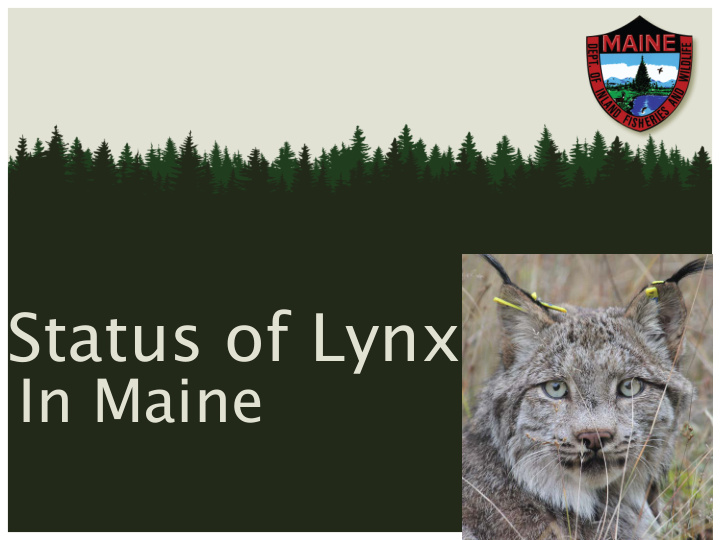



Status of Lynx In Maine
Maine’s Forest - contiguous forestland • ~18 million acres of forest – 6 mill acres spruce/fir • Privately owned-forest mgmt. • Limited development pressures • Easements on 2.5 million acres – Protected from development – Active forest management Distribution of spruce/fir forest type group, Maine 2012 (Homer et al. 2012)
1970-85 Budworm Outbreak
1990s – Today Extensive Areas of Regenerating Forest
Forest Conditions-Forest Inventory Data 3 million of acres of S/F forest Saplin ling Dense se 1982 ½ million 340,000 1995 1 million ½ million 2006 1.4 million 700,000 Source: Maine Forest Service – Ken Laustsen
Forest Inventory UPDATE 2014 1,800,000 Existing Lynx Habitat 1,538,796 1,600,000 Optimal Foraging Habitat (OFH) 1,461,313 1,398,898 1,342,924 1,400,000 1,200,000 1,072,515 1,000,000 Acres 804,742 736,363 800,000 7 06,784 701,140 600,000 507,367 491,412 400,000 339,987 200,000 0 1980 1985 1990 1995 2000 2005 2010 2015
Monitoring Lynx in Maine 1. Radio Telemetry Study: 1999-2011 2. Periodic Winter Snow Track Surveys • 1995-98, 2003-2008, 2015-2017 3. Credible Sightings – MDIFW Staff 4. Incidental Take
Ra Radio Te Telemetry Study: 1999 1999-2011 2011 • Captured 191 lynx • 113 kittens in 43 litters • 85 radioed • Occupy small home ranges • Lynx select best habitats • Good reproduction and survival
Ra Radio Te Telemetry Study: 1999 1999-2011 2011 Budworm Impacted 46% s/f clear cuts
Radio Teleme emetry Study : : 1999 1999-2011 2011 • Home range : 25 km 2 F, 50 km 2 M • Male home range overlaps 3 females
Radio Teleme emetry Study : : 1999 1999-2011 2011 Density • 4.5 adult/100km 2 • 5-9 kittens/100km 2
Radio Teleme emetry Study : : 1999 1999-2011 2011 • Habitat Use - Selection for S/F sapling forest • 1,800-2,300 acres in Female HR • 3,000 -4,000 acres in Male HR
Ra Radio Te Telemetry Study: 1999 1999-2011 2011 • Population demographics – 65% of adult females with kittens – Average litter size: 2.63 (range 1-5) – Kitten Survival: 78% – Annual Adult Survival: 76% (SE=3.37) • Predation • Starvation-lungworm
Reproduction: Lynx Study Area (400km 2 ) Hares/Ha Year AF # Litters Productivity in CC in SHW 1999 1 1 100% 2000 3 3 100% 2001 4 4 100% 2.22 2002 9 9 100% 1.8 2003 7 6 86% 1.85 2004 9 7 78% 1.79 2005 5 4 80% 1.92 0.87 2006 7 1 14% 1.19 0.97 2007 7 2 29% 0.99 0.65 2008 4 0 0% 0.8 0.66 2009 4 0 0% 0.75 0.64 2010 5 5 100% 0.91 0.96 2011 1 1 100% 1 1.31
Population Estimate • Available lynx habitat in northern Maine – FIA • Proportion of habitat occupied – track surveys • Amount of lynx in occupied areas - habitat in h.r. See Appendix IV – Maine’s Lynx Assessment
2006 Population Estimate 750 – 1,000 Adult Lynx
2015 Population Estimate > 1,000 Adult Lynx
Credible Sightings
Indices suggest Maine’s lynx pop still increasing Roa oad M Mor orta talities Inci cidental Cap Captures i in Tr Trap aps
Periodic Winter Track Surveys • Snowmobile 55-80 km Unplowed Roads / 100km2 • 24-72 hrs. after snow/wind event • GPS survey route and track intercepts • Collect additional data at track – Photograph – Measurements – Assign STQ – Number of Individuals – Direction of Travel
Monitoring Lynx – Track Surveys Time p e per eriod Number of of t town owns Number of of t town owns % o occu cupied survey eyed ed wit with ly lynx 1995-1998 116 10 9% 2003-2008 91 43 47% 2015 24 19 79% 19 towns surveyed in 2003-08 and 2015 Time p e per eriod Number of of t town owns Number er o of % o occu cupied survey eyed ed town wns with with ly lynx 2003-2008 19 11 58% 2015 19 18 95%
Preliminary Occupancy Models 2003 2015 Naïve estimate: 17/19 towns Naïve estimate: 18/19 towns Ψ = 0.897 +/ - 0. 0.07 07 S SE Ψ = 0.951 +/ - 0. 0.05 05 S SE Mean D Detecti tion on rate tes: Mean D Detecti tion on rate tes: p = 0.065 +/ - 0.007 SE p = 0.176 +/ - 0.010 SE Ψ = 0.80 +/ - 0.08 SE
Detection Higher 2015 =2003 tracks =2015 tracks
Future Surveys • Surveys to continue 2016 and 2017 – Resurvey areas previously surveyed – 25 towns each year for 3-4 years. – Same survey design • Occupancy modeling – • Has Occupancy Increased (i.e., expanding)? • Has Prob. Of Detecting Lynx Increased? • Has density/pop increased?
Models 2003-08 Track surveys Found lynx in 22 of 55 Low Probability • 13 of 18 High Probability •
Models
Current Models: Data • From colonizing population of lynx that occupied best habitat first • Limited data on value of Partial Harvest – Most of s/f forest cut in 1980s – PH in remaining smaller patches of s/f or mixed forest
Future • Another Budworm Outbreak on Horizon • FPA – allowances for larger clearcuts – Wildlife Value – Response to disease • Will PH in maturing s/f forest provide adequate habitat for hares and lynx?
Shelterwoods –emulate clear cuts
Summary • Maine’s lynx population is robust • Populations are still increasing • Forest disturbance benefit lynx • Land Use Regulations did not lead to current conditions • Provide private land managers forest stand characteristics that support hares and lynx
Recommend
More recommend